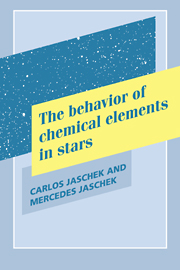Book contents
- Frontmatter
- Contents
- Preface
- Part One Content description
- Part Two Content description
- Part Three Content description
- 1 Terminology of spectral lines
- 2 The selection of stars
- 3 Line identification
- 4 Equivalent widths
- 5 Abundances
- 6 Afterthoughts
- Part Four Content description
- References
- Index of elements in stars
- Index of molecules in stars
6 - Afterthoughts
Published online by Cambridge University Press: 06 July 2010
- Frontmatter
- Contents
- Preface
- Part One Content description
- Part Two Content description
- Part Three Content description
- 1 Terminology of spectral lines
- 2 The selection of stars
- 3 Line identification
- 4 Equivalent widths
- 5 Abundances
- 6 Afterthoughts
- Part Four Content description
- References
- Index of elements in stars
- Index of molecules in stars
Summary
Let us conclude the book with some general reflections.
After reading this book we hope that readers will conclude that our knowledge of the behavior of the chemical elements in stars has advanced significantly since the time of Merrill's (1954) book The Behavior of Chemical Elements in Stars. In this book, which is an excellent summary of the state of knowledge in the early 1950s, Merrill was able to report on 41 elements, whereas in this book we now have some information for 85 elements. In Merrill's time, studies were based upon the optical wavelength region (approximately 3000–8000 Å), but now we are able to provide results from the ultraviolet to the extreme infrared and the radio region. This has helped very much in the detection of molecules – whereas Merrill quoted some 40 molecules, we are able to list 89.
Progress is clearly visible in the production of papers on stellar spectroscopy. In Merrill's time, the annual production was of the order of 100 papers per year, whereas we now find about 1000 papers annually. It is thus legitimate to conclude that knowledge of the subject has advanced significantly.
However, if one regards the subject in more detail, a number of black spots appear on this rosy picture. A perusal of this book shows for instance that, for many of the elements discovered, we still do not know how they behave in stars of the main sequence, not to speak of their behavior in other regions of the HR diagram.
- Type
- Chapter
- Information
- The Behavior of Chemical Elements in Stars , pp. 283 - 288Publisher: Cambridge University PressPrint publication year: 1995

